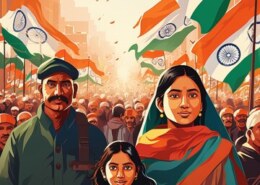Examine the civic society’s role in promoting secular values in India today.
The intersection of caste and religion in India profoundly influences the discourse around secularism and social justice. This relationship is complex, as both caste and religion are deeply embedded in the social fabric of Indian society and often intersect in ways that can challenge the principlesRead more
The intersection of caste and religion in India profoundly influences the discourse around secularism and social justice. This relationship is complex, as both caste and religion are deeply embedded in the social fabric of Indian society and often intersect in ways that can challenge the principles of secularism. Here are some key aspects to consider:
1. Caste as a Social Hierarchy
- Caste System: The caste system categorizes individuals into hierarchical groups based on birth, affecting access to resources, education, and social mobility. This social stratification can often overlap with religious identities, as many communities are linked to specific castes.
- Religious Dimensions: Certain religions in India, particularly Hinduism, have caste-based stratifications encoded in their texts and practices. This complicates secularism, as it raises questions about how religious practices can be reconciled with the ideals of equality and justice.
2. Secularism and Caste Discrimination
- Legal Framework: While the Indian Constitution guarantees equality and prohibits discrimination based on caste, the reality often falls short. The intersection of caste and religion can lead to continued social exclusion and discrimination, challenging the efficacy of secular principles.
- Affirmative Action: Policies aimed at addressing caste-based inequalities, such as reservations in education and employment, are essential for promoting social justice. However, these policies can sometimes lead to tensions, particularly when religious groups perceive them as unfair advantages for specific communities.
3. Communalism and Caste Politics
- Political Mobilization: Political parties often exploit both caste and religious identities to consolidate support. This can lead to a scenario where communal politics overshadows secular governance, with caste-based considerations influencing electoral strategies and policy decisions.
- Identity Politics: The intertwining of caste and religion can result in identity politics that reinforces divisions rather than promotes unity. Such dynamics can challenge the secular ideal of a society where individuals are seen beyond their communal identities.
4. Social Justice Movements
- Intersectional Activism: Movements advocating for social justice increasingly recognize the need to address both caste and religious discrimination. This intersectional approach seeks to create alliances across communities to combat systemic inequalities and promote inclusive policies.
- Caste-Religious Solidarity: Some social justice movements emphasize the need for solidarity among marginalized groups, regardless of caste or religion, advocating for a broader understanding of equality that encompasses various forms of discrimination.
5. Impact on Secular Education
- Curriculum and Representation: Educational content often reflects societal biases related to caste and religion. Secular education can help challenge stereotypes and promote a more inclusive understanding of Indian history and culture, but it can also reproduce existing hierarchies if not critically examined.
- Empowerment through Education: Efforts to provide equitable educational opportunities can empower marginalized communities and help dismantle caste-based discrimination, thereby supporting the principles of secularism and social justice.
6. Religious Reform Movements
- Challenging Caste Within Religions: Some religious reform movements, particularly within Hinduism and Buddhism, actively challenge caste discrimination, advocating for a more egalitarian interpretation of religious texts. These movements often align with broader secular and social justice goals.
- Interfaith Initiatives: Interfaith dialogues that address both caste and religious discrimination can foster mutual understanding and cooperation among different communities, promoting a more cohesive secular society.
Conclusion
The intersection of caste and religion poses significant challenges and opportunities for secularism and social justice in India. Addressing these intertwined issues requires a nuanced approach that acknowledges the historical and social complexities at play. Promoting inclusive policies, encouraging inter-community dialogue, and fostering a critical examination of both caste and religious identities are essential for advancing the goals of secularism and achieving social justice in contemporary India.
See less

Civil society plays a crucial role in advocating for secular values in contemporary India. Through various organizations, movements, and initiatives, civil society actively works to promote tolerance, protect minority rights, and reinforce the principles of secularism. Here’s an analysis of their coRead more
Civil society plays a crucial role in advocating for secular values in contemporary India. Through various organizations, movements, and initiatives, civil society actively works to promote tolerance, protect minority rights, and reinforce the principles of secularism. Here’s an analysis of their contributions:
1. Awareness and Education
2. Legal Advocacy
3. Interfaith Dialogue
4. Mobilizing Grassroots Movements
5. Research and Documentation
6. Solidarity and Support
7. Challenging Extremism
Conclusion
Civil society in contemporary India is a vital force in advocating for secular values, promoting tolerance, and challenging divisive narratives. Through education, legal advocacy, interfaith dialogue, and grassroots mobilization, these organizations contribute to a more inclusive society. However, they often face challenges, including political resistance and societal polarization, making their role even more critical in the ongoing struggle to uphold secularism in India.
See less